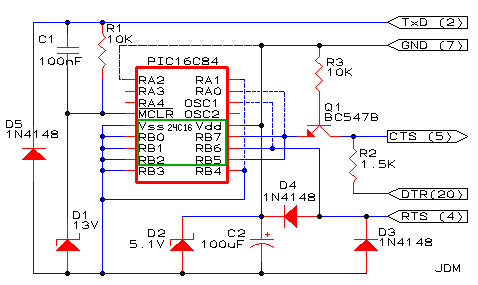The "pic" on the VHF FM tx just got un-programed.... during tests I cycled the power on butom too fast and that for sure affected something in the internal memories... now it tunes from 148 to 152 and doesn't let me going down or up from this loop....ooh well! I will program the chip again. Anyhow I allready manage to make 3 QSO's with the radio.
Put myself making a simple packet TNC using a pic 16F88 but my simple pic programer refuses to program this model, from what i've searched I am not the only one with this issue... if you have programed the 16F88 with a simple programer please let me know the shcematic...
The simple packet TNC (once programed) will connect a VHF single channel data transceiver module I bought the last ham fair I attened....the programer is as simple as 2 diodes from rs232 txd and rxd to the program pin on the module (connects internaly to RB3 on the PLL PIC)..how dificult can it be?...doesn't work! Trying to sort this one out is driving me crasy! The VHF module is still programed in 156Mhz not exactly what I want...

The simple DT-102 module programer

..I also connect ping 4 on the VHF module side to ground, I think it was missing in the shcematic....see the internal module schematic an let me know if I am not right on this decision.

...pin 4 is ground...anyhow it doesn't work this way or by the programer schematic! Must try in another computer, could be something on the rs232 side....but my another computer doesn't have a floppy drive (to boot the programer software that runs in DOS)... I have a programer software version that runs on Windows...but hell, I will no put that #$%it on any of my computers! :)
On the more or less good side I built a smal VHF FM test transmiter using an 10.7 ceramic ressonator modulated by a varicap to mix the double frequency (21.4) with the Si570 VFO....now, since I don't have a 21.4 filter... I have the 2m frequency output plus or minus 21.4 and 10.7... but at least it works. The mixing is done in an NE602, as soon as I start sorting this issues I will probably use this for transmiter since the Si570 can give the channel step the PLL doesn't.
Here is the test board. The unfiltered and un-amplified test output is just a small piece of wire to pin 5 on the NE602:


I am also looking for a 12.5Khz step PLL replacement for the allready built VHF FM transmiter, this two options look promissing:
http://sq6ade.elektroda.eu/tsa6057.html
http://www.garex.co.uk/AKD/2001_12.5.htm
...Anyhow, no LCD and in both cases a TSA6057 pll chip is needed
 The dash lines are not connected in my prototype and it's a 16F88 pic in place.
The dash lines are not connected in my prototype and it's a 16F88 pic in place.














